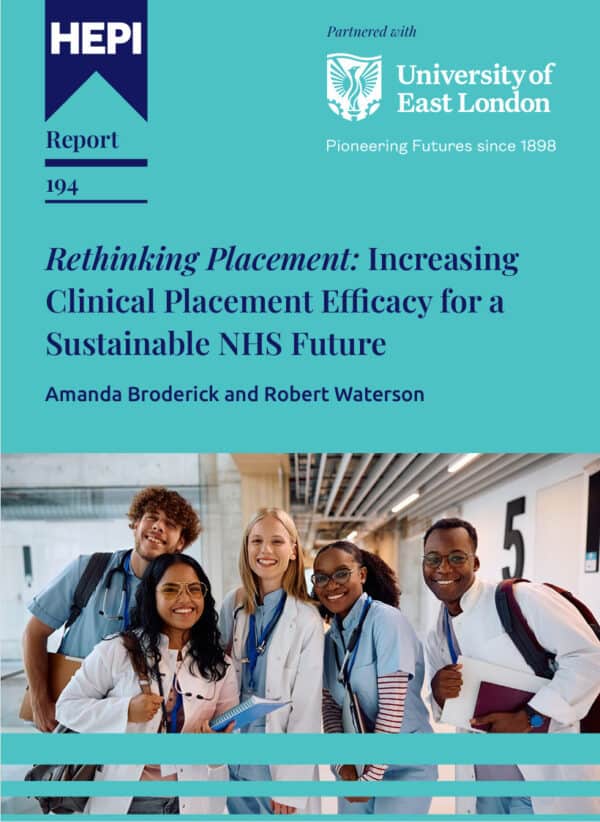Universities and economic growth in the Commonwealth
Join HEPI for a webinar on Thursday 11 December 2025 from 10am to 11am to discuss how universities can strengthen the student voice in governance to mark the launch of our upcoming report, Rethinking the Student Voice. Sign up now to hear our speakers explore the key questions.
This blog was kindly authored by Professor Colin Riordan, Secretary General, The Association of Commonwealth Universities.
Governments throughout the Commonwealth are faced with a familiar dilemma. Once seen as central to nation-building, poverty reduction and technological self-sufficiency, universities in many countries face scepticism and waning public support. At a time when cost of living pressures are relentless, institutions are increasingly seen as ‘a kind of elite luxury that the taxpayer pays for’, as Michael Ignatieff recently put it. But that narrative misses the point. New evidence shows that investment in higher education delivers measurable, long-term economic growth – the kind that no government can afford to ignore.
Education as economic infrastructure
The evidence is revealed in a new study, undertaken by London Economics at the request of The Association of Commonwealth Universities, to investigate the link between investment in higher education and economic growth.
The study found that a hypothetical 1% increase in the proportion of the population obtaining tertiary education qualifications (tertiary attainment) in 2025 would boost Commonwealth GDP by US$28 billion in 2029. That’s in addition to further increasing annual gains along the way, a clear sign that higher education returns compound over time.
Why does this matter? Well, it is clear that many, if not all, of the pressures on universities stem from a paucity of resources following on from the 2008 financial crisis (from which many large economies have still not recovered); from the Covid pandemic; and from an upturn in conflicts across the world that are costly drains on the public purse. The difficulties are exacerbated by locally specific problems, including natural disasters such as drought, flooding, and extreme weather events, as well as political events such as Brexit, trade wars, and political instability.
Governments have to find ways to restore their position in the face of these headwinds, and higher education can easily be depicted as part of the fiscal problem rather than of the solution. Demonstrating the return on investment in higher education will allow education ministers to go well-armed into the conference chamber with their finance ministers and national leaders.
Beyond the balance sheet
There are other economic arguments for universities, of course. Their knock-on effects through research and innovation, as employers, and as attractors of foreign direct investment, all come in addition to their core educational function. Universities improve public health outcomes, generate productivity gains, and strengthen civic life. But making the case for higher education as central to national prosperity is essential at a time when governments are facing seemingly intractable difficulties.
The message, then, is clear: far from being a luxury perk for the elite, expenditure on higher education is an investment in critical national infrastructure. Building opportunities in higher education equates to building a road to future prosperity. Unlike eye-catching projects involving new roads, railways, bridges or airports, however, increasing the proportion of the population with higher education qualifications requires a leap of the imagination, and an array of arguments to be marshalled.
Certainly, a clear vision of how the world will be different as a result of such an investment is critically important. Voters and populations want to know what difference more university places will make to their lives. It is up to politicians to set out that vision, but they themselves must first be persuaded, and so we must marshal further helpful arguments to support them.
A shared responsibility
Firstly, the investment does not have to come solely from the public purse. Tertiary attainment is the proxy that implies prior increases in expenditure on higher education, which could include private investment, partnering with overseas institutions, changing the proportion of the cost for which the individual is responsible, or imaginative loan schemes. Reformulating incentives and requiring efficiencies could certainly be in the mix. So, no education minister should need to envisage themselves going cap-in-hand to the finance department.
On the contrary, they can offer the prospect of contributing to the public coffers in due course. Depending on the size of the country and the proportion of tax take, this could range from the US$ billions in a country like India to hundreds of millions in Bangladesh and many tens of millions in Kenya.
A call to reimagine policy
In a country like the UK, the GDP boost of a hypothetical 1% increase in tertiary attainment in 2025 would amount to £4.9 billion in 2029. This means that increasing capacity in higher education is fiscally prudent as well as being the most important tool we have to future-proof the economy and improve productivity in an age of AI-driven technological transformation. But in low-income countries, the multiplier effect is even higher, and so the argument for investment is stronger still.
Commonwealth countries with rapidly growing youth populations face an urgent need to expand tertiary access if they are to harness their demographic dividend. Targeted investment in higher education is one of the most effective levers to drive inclusive, sustainable economic growth. The evidence supports stronger collaboration between governments, universities, and international funders to build tertiary systems that deliver for national economies.
With all necessary caveats in relation to correlation versus causation, the results of the London Economic analysis are compelling. Governments that embed higher education policy into national economic planning and industrial strategies, and invest in universities as economic assets and hubs for talent development, innovation and productivity, will do more than balance their budgets: they will secure their future.







Comments
Paul Wiltshire says:
More free advertising for the Uni Sector
Reply
Jonathan Alltimes says:
The economic causal model is as follows:
1) Higher education provides skills for employers.
2) The skills are organised into production.
3) The organised production is sold at specific volumes over time.
4) Wages are paid to organised production.
5) Wages buy other organised production.
The most significant bit of information in the report confirms what we already know from decades of economics research in real large-scale business firms, research and development is likely to have a much larger causal effect on economic growth than simply the number of people in tertiary education. R&D is a partial proxy indicator of the breadth and depth of organised specialisation in production. Business firms only invest in R&D if they are likely to be able to appropriate the benefits with the protection of their property rights in organised production, as R&D is inherently riskier for new organised production than for existing organised production. The skills required for R&D are not the same as in tertiary education, as research training and more specialisation is required. R&D specialisation multiplies the effect of organised production through innovation, that is, the commercialisation of inventions and problem solving in the form of new products, new services, new projects, new systems, and new organisations. Specialisation in R&D requires matching specialisation in the the other functions of the business firm for commercialisation.
Government funded research should be concentrated in research-led universities, whose private sector economic value is in specialised in idiosyncratic skills and not academic papers. Research-led universities should be able to match the specialisation requirements of employers, locally, regionally, and nationally and, should be able to compete with the best research institutes in the world in every industry sector. Public sector value of such skills has many values other than the economic.
A conventional economic analysis would focus on the importance of factor substitution, inducements for investment, and developing core technologies. Rather it is argued that the scope for investment in the development of firm-specific experience is the main source of enduring differences in the innovative performance of firms, and hence at the sectoral level for the economic performance of nations. An alternative economic analysis would therefore focus on local factor endowments, technological accumulation and intersectoral linkages, and tacit knowledge.
Reply
Add comment